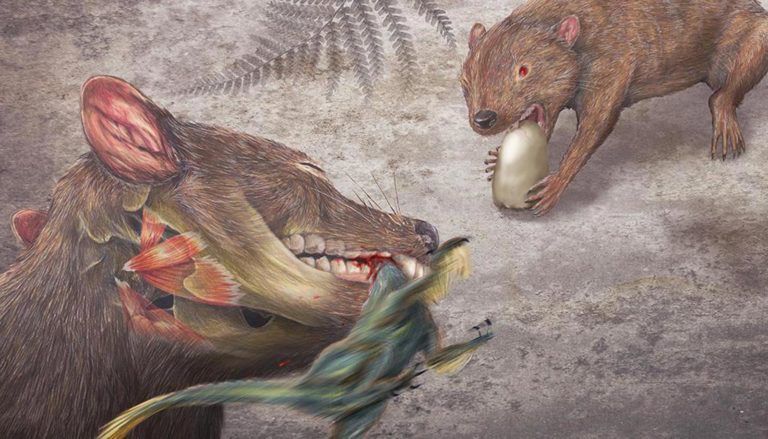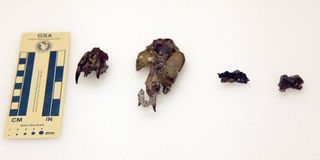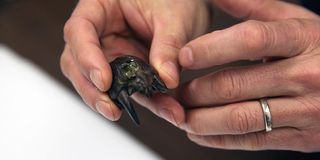Ancient Marsupial Relative May Have Eaten Little Dinosaurs

An ancient mammal the size of a badger may have used its bone-crushing canines and powerful bite to take down little dinosaurs, researchers have found. In fact, the little guy could chomp down with more force, pound for pound, than any other mammal on record.
The creature (Didelphodon vorax), an early marsupial relative, lived during the last few million years of the Mesozoic, or dinosaur age, in what is now present-day Montana and North Dakota, the researchers said.
The new findings upend an old theory suggesting that marsupials originated in South America. Rather, an analysis of D. vorax's anatomical features suggest that marsupials originated in North America a good 10 million to 20 million years earlier than scientists thought. Later, these early marsupials would have dispersed and diversified in South America, the researchers said. [Early Marsupial Relative's Powerful Bite Could Kill Little Dinosaurs | Video]
"What I love about Didelphodon vorax is that it crushes the classic mold of Mesozoic mammals," the study's lead researcher Gregory Wilson, an adjunct curator of vertebrate paleontology at the Burke Museum in Seattle, and an associate professor of biology at the University of Washington, said in a statement. "Instead of a shrew-like mammal meekly scurrying into the shadows of dinosaurs, this badger-sized mammal would've been a fearsome predator on the Late Cretaceous landscape — even for some dinosaurs."
Hell Creek fossils
Researchers found the four fossil specimens in rock dating to about 69 million to 66 million years ago in the Hell Creek Formation. Before these four individuals were unearthed, researchers knew about 60 species of metatherians (marsupials and their closest relatives) from the Cretaceous period (145.5 million to 65.5 million years ago) of North America. But most of these were fragments of jawbones or teeth, which provided only limited information about marsupial's closest relatives.
In contrast, the new findings include an almost complete skull from the North Dakota Geological Survey State Fossil collection, a partial snout and an upper jawbone from the Burke Museum's collections and another upper jaw from the Sierra College Natural History Museum in California.

These never-before-seen parts of D. vorax's body indicate that these marsupial relatives were the largest metatherian to live during the Cretaceous, the researchers said. It likely weighed from 5.3 lbs. to 11.5 lbs. (2.4 to 5.2 kilograms), they said.
Sign up for the Live Science daily newsletter now
Get the world’s most fascinating discoveries delivered straight to your inbox.
In order to test the creature's bite force, the researchers took a computed tomography (CT) scan of the fossils, and determined where the jaw muscles would have attached to the skull. By comparing these muscles with those of modern animals, whose bite forces are known, the researchers were able to determine that D. vorax had the strongest bite of any mammal, alive or extinct.
Moreover, D. vorax's canines are similar to those of living felines and hyenas, indicating that these ancient creatures could probably bite into bone while hunting prey, the researchers found. Its extraordinary bite force, when combined with its canines, shearing molars and big, rounded premolars, suggest that it could have crunched on shells and even small dinosaurs, they added.
"I expected Didelphodon to have a fairly powerful bite based on the robust skull and teeth, but even I was surprised when we performed the calculations and found that, when adjusted for body size, it was capable of a stronger pound-for-pound bite than a hyena," said Abby Vander Linden, who performed the research as a research technician at the Burke Museum, and is now a graduate student at the University of Massachusetts Amherst. "That's a seriously tough mammal," [In Photos: Mammals Through Time]
Dental scratches
The researchers also compared the tiny pits and scratches (known as microwear) on D. vorax's teeth with those found on other fossilized and modern teeth. They found that D. vorax was an omnivore that ate vertebrates, plants and hard-shelled invertebrates, including mollusks and crayfish, as well as insects, spiders and annelids (earthworms and leeches).
"The interesting thing about these fossils is that they allowed us to study the ecology of Didelphodon from many angles," said study co-author Jonathan Calede, a former biology graduate student at the University of Washington who is now a visiting assistant professor at Bucknell University in Pennsylvania. "The strength of the conclusion comes from the convergence of microwear with bite-force analysis, studies of the shape and breakage of the teeth, as well as the shape of the skull as a whole."

What's more, the new marsupial family tree will help researchers understand where marsupials developed over time. For instance, they found five major lineages of marsupials and their relatives that diverged in North America from 100 million to 85 million years ago.
Intriguingly, marsupial relatives grew in size and expanded their diet just as other early mammals and flowering plants began to diversify. However, much of this North American diversity gradually faded from 79 million to 66 million years ago, and then abruptly disappeared when the asteroid collided with Earth and killed the nonavian dinosaurs. But marsupials managed to live on, diversifying and evolving in their new South American home.
The study was published online Dec. 8 in the journal Nature Communications.
Original article on Live Science.

Laura is the archaeology and Life's Little Mysteries editor at Live Science. She also reports on general science, including paleontology. Her work has appeared in The New York Times, Scholastic, Popular Science and Spectrum, a site on autism research. She has won multiple awards from the Society of Professional Journalists and the Washington Newspaper Publishers Association for her reporting at a weekly newspaper near Seattle. Laura holds a bachelor's degree in English literature and psychology from Washington University in St. Louis and a master's degree in science writing from NYU.











